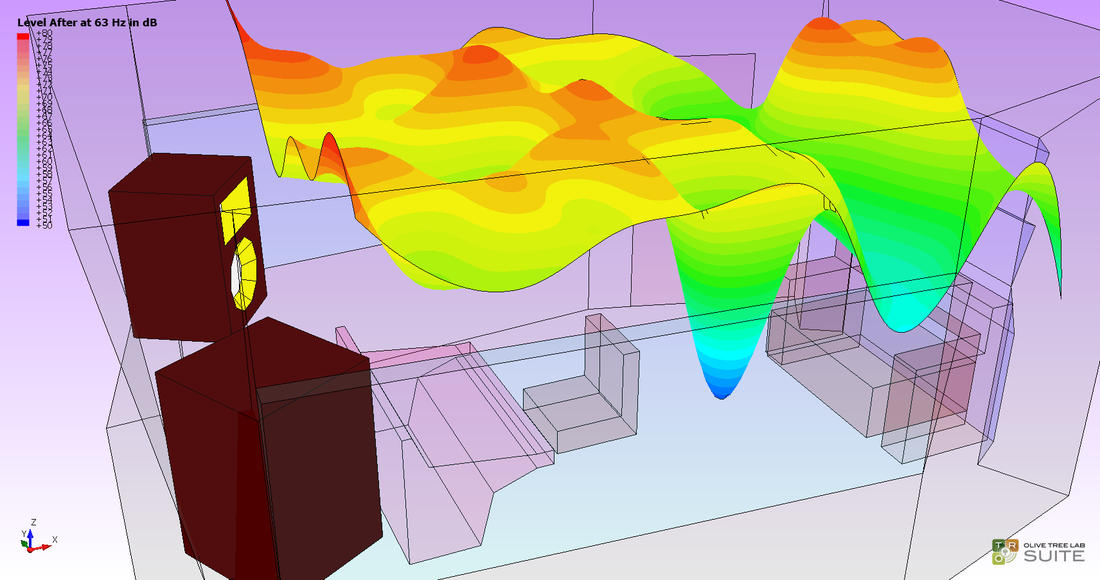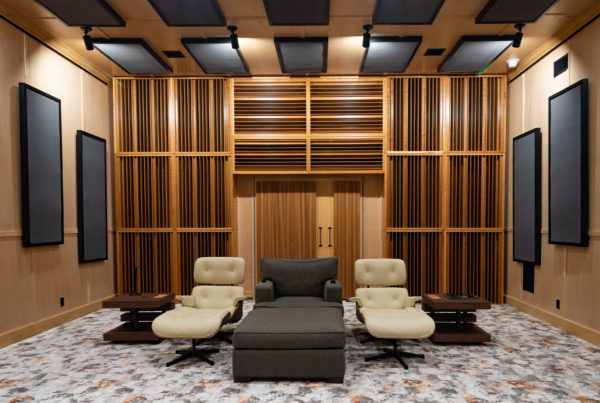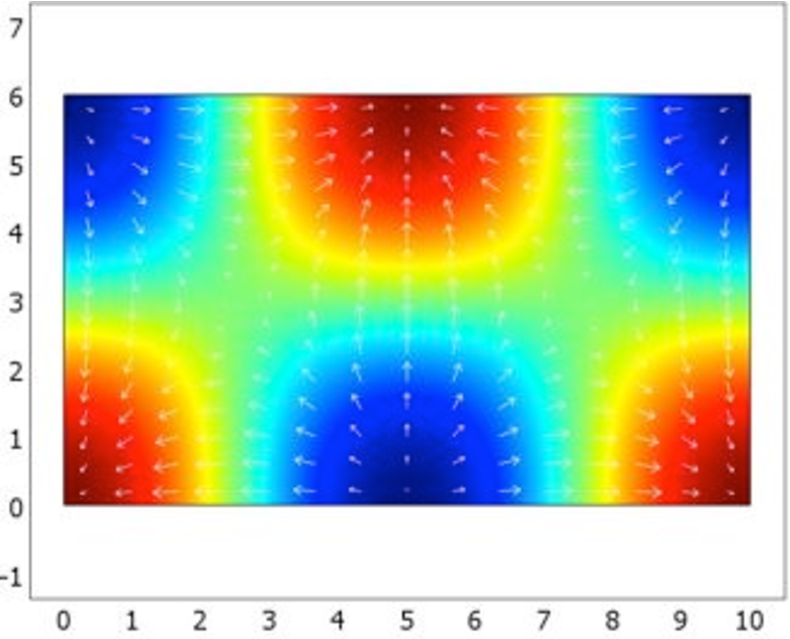
Table of Contents
Understanding Room Modes and Wavelengths
To calculate room modes, you need an understanding of physics and math. When you need to calculate room modes you must understand that all energy has wavelengths. Wavelengths are just what the name implies. They are waves of energy (frequencies) that have length. The waves are the energy created and the length corresponds to the frequency you are using to calculate room modes.
Lower frequency energy is much longer than middle and high frequency energy. Let’s look at some examples. A 40 hz. wave of energy is 28′ long. A 30 hz. wave of energy is 38′ long. If you look at 100 hz. wave energy, it is 13′ long. The higher the frequency the shorter each frequency or wavelength gets in size. You can see the frequency and the associated wavelengths in the chart below.
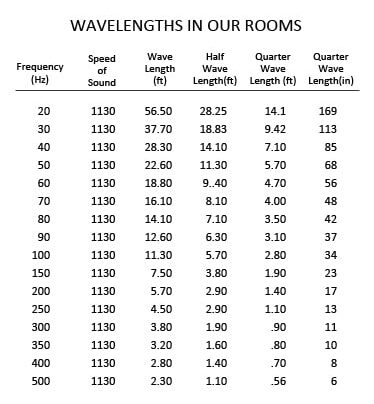
The Importance of Wavelengths in Room Acoustics
To calculate room modes, you must understand that all energy has a length. The length of the individual frequencies is the life cycle of that energy. It is its lifespan. A 40 hz. wave of energy needs 28′ to exist and have a life without hitting a room boundary surface. The wavelength must have enough distance to fully form and extend its full length. The length of each wavelength determines the size or distance the wavelength must have in order to live its full life.
It must be able to travel its full distance and be able to live and die on its own volition without the interference from room walls, floor, or ceilings. If the dimensions of the room will not permit the required distances for the frequency wavelengths to fully form then we have modal distortion. Modal distortion is never wanted in any critical listening environment. It must be identified and treated in order to achieve a higher room resolution.
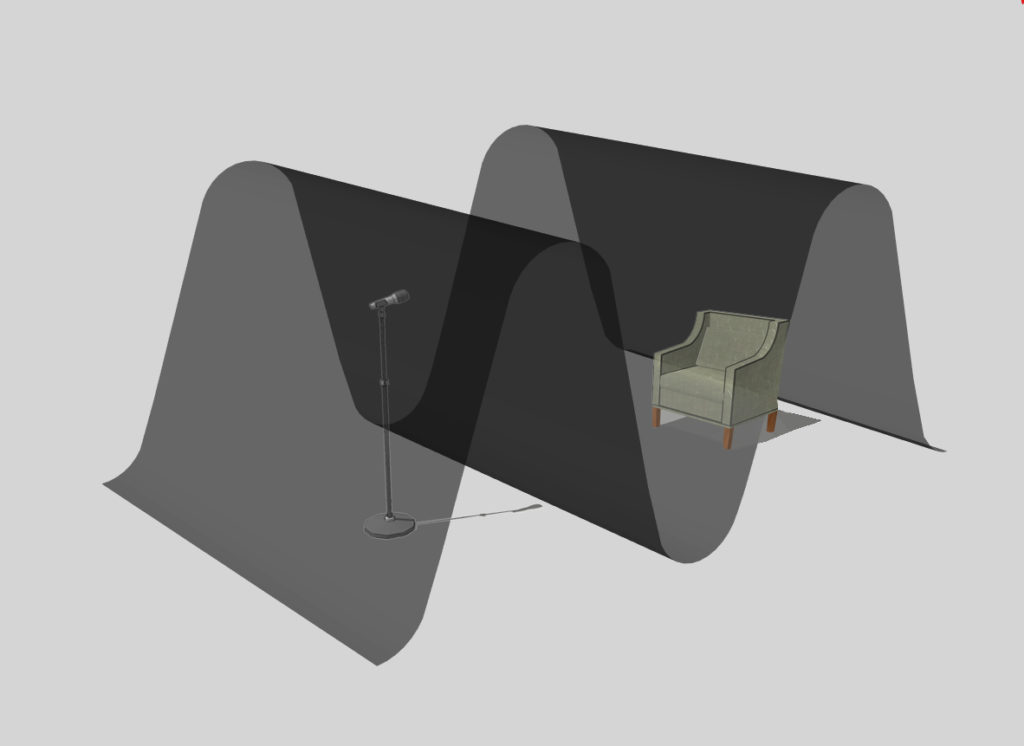
Impact of Room Dimensions on Room Modes
When you calculate room modes, you are trying to find the frequency and amplitude of the room mode. The reason for this is that room modes are a form of pressure distortion. When a wavelength will not fit into the dimensions of a room, the air between those two surfaces, a sidewall to sidewall, floor to ceiling, or the front to rear soundfield gets pushed into excitement causing the air molecules to vibrate and bump into each other.
When this happens, there are two audible events that occur. One will hear too much of some frequency or none at all. We have exaggeration and attenuation as our extremes with no in betweens. You either hear too much of something or nothing at all. Room modes are the most extreme of all room distortions. There are three different room modes. https://en.wikipedia.org/wiki/Room_modes

Types of Room Modes: Axial, Tangential, and Oblique
We have axial modes which occur between two parallel surfaces such as floor to ceiling, sidewall to sidewall, and front to rear. Axial modes have the greatest strength or amplitude. The misused term “bass boom” is an example of excessive lower frequency modal energy. Tangential modes occur between four surfaces. We can have tangential modes between the floor to ceiling and sidewall to sidewall.
We can have tangential modes from sidewall to sidewall and front to rear of the room. Oblique modes are unwanted pressure modes between six surfaces. Oblique modes are created by the sidewalls, floor, ceiling, front and rear walls. With oblique modes we have every surface of every room directly contributing to the modal issue. In every small room we must select the appropriate dimensions to minimize all three room modal distortion types.
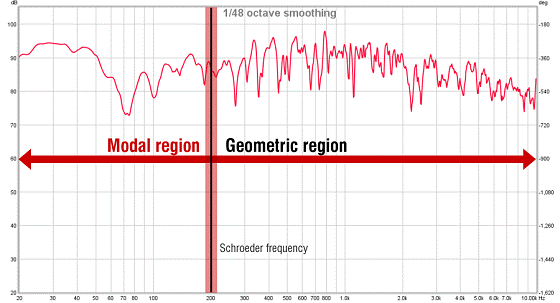
How to Calculate Room Modes and Identify Modal Distortions
When we decide to calculate room modes, we are looking for the frequency and amplitude of all wavelength frequency energy that does not fit into the dimensions of our critical listening rooms. We need to locate the frequency and how strong that mode is and where it is located within our room. Room modes occur approximately every three feet within most rooms. It is the dimensions of the room that determine what frequency will not fit and just as important how strong that mode is. Since it is the wall itself that produces the problem of modes, we must use the wall as a treatment source for the modal issue.
Using our CAW system where we manage room modes within the wall itself saves room space. that would be required for the treatment of all room modes. The lower frequency room modes take 12″ of space to treat. With this space requirement. it is much more cost effective from a material, space, and performance objective to build the modal management technology into the structure.
We have a process called the CAW which stands for Carbon Absorbing Wall. We can assist you in locating all room modes. Fill out the information in this link and schedule a call to examine your room modal issues and how to treat them. Include up to six pics of your room within the form.
Calculate Room Modes FAQs
What are room modes and why are they important in acoustics?
Room modes are specific frequencies at which sound waves resonate within a room, caused by the room’s dimensions and shape. They occur when sound wavelengths coincide with the distances between walls, floor, and ceiling, leading to areas of excessive or diminished sound pressure. Understanding room modes is crucial because they can cause uneven sound distribution, resulting in exaggerated or attenuated frequencies. This affects the clarity and accuracy of audio in critical listening environments like studios and home theaters.
How do I calculate the room modes for my space?
To calculate room modes, you’ll need to consider the room’s dimensions (length, width, and height) and understand that each sound frequency has a specific wavelength. Use the formula: Frequency = 𝑛 x 𝑐 / 2 x 𝑑
where 𝑛 is the mode number (an integer), 𝑐 is the speed of sound (approximately 343 meters per second), and 𝑑 is the room dimension in meters. Calculate this for all three dimensions to find the axial modes. Identifying these frequencies helps in understanding which sound waves will resonate and potentially cause acoustic issues.
What are axial, tangential, and oblique room modes?
Axial modes occur between two parallel surfaces (e.g., floor to ceiling, sidewall to sidewall) and have the greatest impact on room acoustics due to their strength. Tangential modes involve four surfaces, such as two pairs of opposite walls. Oblique modes are the result of reflections from all six surfaces (four walls, floor, and ceiling). Each type contributes differently to the room’s acoustic characteristics, with axial modes being the most significant to address.
How does room size and dimensions affect room modes?
The size and proportions of a room directly influence which frequencies become problematic. Larger rooms can accommodate longer wavelengths (lower frequencies) without significant resonance issues, while smaller rooms may amplify or diminish certain frequencies due to the limited space for sound waves to fully develop. Ideally, room dimensions should be designed to distribute room modes evenly across the frequency spectrum to minimize acoustic distortions.
How can I treat or manage room modes in my listening environment?
Managing room modes involves identifying problematic frequencies and applying acoustic treatments to reduce their impact. Solutions include bass traps, diffusers, and absorptive materials placed strategically to absorb or scatter excessive sound energy. For severe issues, constructing or modifying walls using specialized materials—like the Carbon Absorbing Wall (CAW) system—can be effective. This system integrates treatment into the room’s structure, saving space and enhancing performance. Consulting with acoustics professionals can provide tailored solutions based on your room’s specific modal issues.


